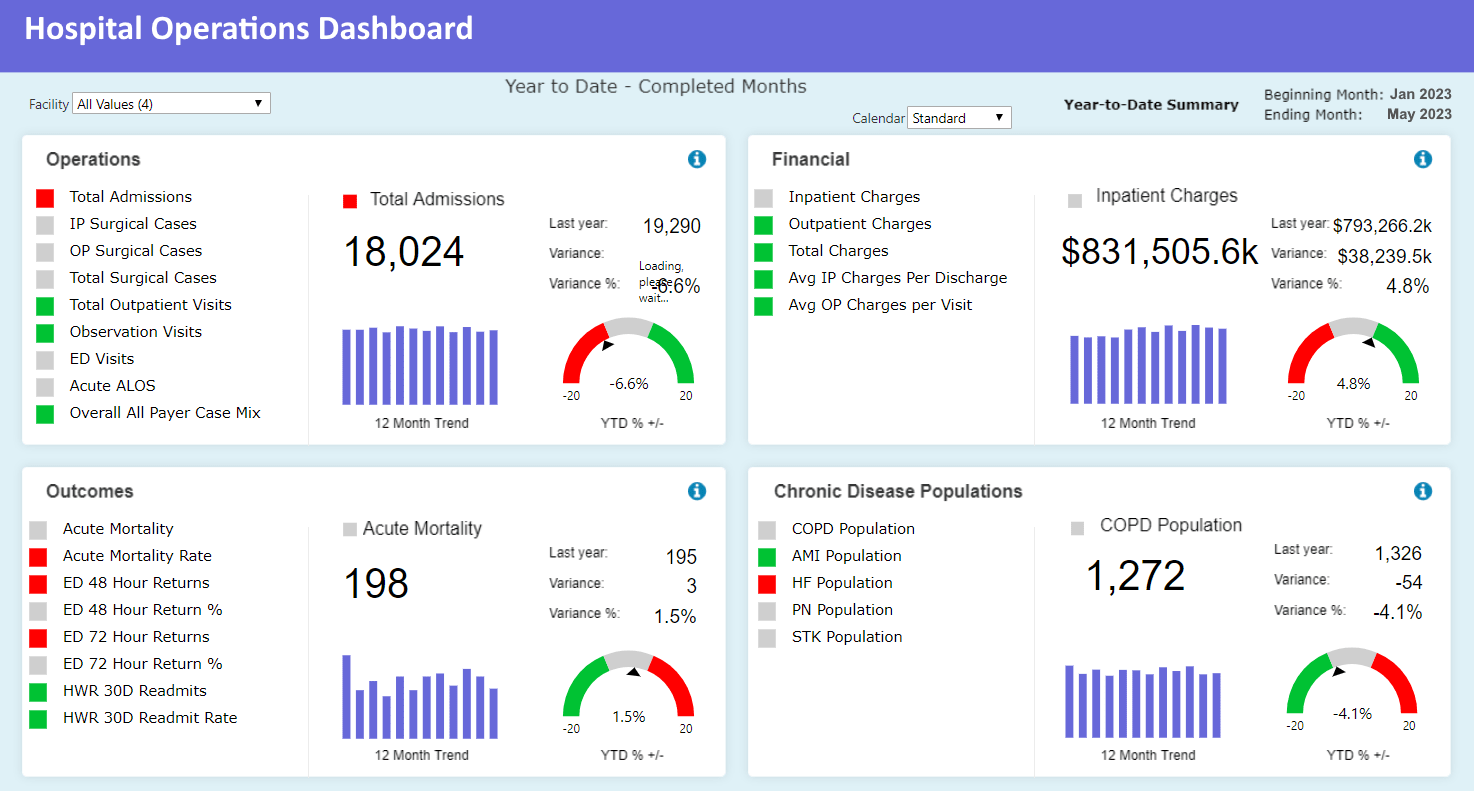What Key Performance Indicators Do Hospital Operations Analysts Use?
Hospital operations personnel must report out on areas for improvement or correction for upper management. These professionals use key performance indicators (KPIs) and analytics to assess and track the performance of their hospitals in order to make educated choices.
In this article, we will cover the key performance indicators (KPIs) and analytics that are used by hospital operations experts.
| #1 Ranking: Read how InetSoft was rated #1 for user adoption in G2's user survey-based index | Read More |
Patient Satisfaction Metrics
Patient satisfaction is one of the most important KPIs for hospital operations experts. Because they gauge how successfully hospitals are serving patients' needs and expectations, patient satisfaction measures are crucial. Patient satisfaction may be measured in a number of ways, including via surveys, feedback forms, and other means. To assess the level of care and support offered by their hospitals, hospital operations professionals utilize these criteria.
Operational Efficiency Metrics
Another essential KPI for hospital operations personnel is operational efficiency measurements. The efficacy of the hospital's resource use, cost-effectiveness, and productivity are gauged by these indicators. Operational efficiency measurements include, for example:
Average length of stay
This measure calculates how long patients stay in the hospital on average. If patients are being released on schedule and effectively, hospital operations professionals may use this measure to gauge that.
Bed occupancy rate
This statistic calculates the proportion of hospital beds that are occupied. To determine if their hospitals are using their resources as efficiently as possible, hospital operations professionals utilize this statistic.
Turnaround time
This statistic calculates how long it takes hospital employees to execute tasks like processing lab tests or admitting patients. This statistic is used by hospital operations professionals to identify places where procedures might be strengthened to boost productivity.
 |
Learn about the top 10 features of embedded business intelligence. |
Clinical Quality Metrics
Because they gauge the caliber of treatment the hospital offers, clinical quality measures are crucial for those working in hospital operations. These criteria are used to evaluate clinical results, patient safety, and therapeutic efficacy. Clinical quality measures include, for instance:
Mortality rates
This statistic counts the number of fatalities for every 100 patients. The efficacy of medical interventions in hospitals is evaluated by hospital operations professionals using this measure.
Readmission rates
This metric counts how many patients are readmitted to the hospital within a certain time frame after being released. To assess the quality of care offered by their institutions, hospital operations professionals utilize this statistic.
Infection rates
This indicator counts the number of people who get infections while hospitalized. To assess how well infection control procedures are working, hospital operations professionals utilize this statistic.
 |
Learn the advantages of InetSoft's small footprint BI platform. |
Financial Metrics
Professionals in hospital operations depend on financial measurements since they assess the institution's financial standing. These measurements assist hospital operations specialists in identifying opportunities for investments, revenue growth, and cost reduction. Financial measures include, for instance:
Revenue per patient
This indicator counts the amount of money made from each patient. In order to assess the hospital's financial performance and spot potential for revenue development, hospital operations professionals utilize this statistic.
Operating margin
The disparity between a hospital's income and costs is gauged by this indicator. This statistic is used by hospital operations professionals to assess the financial performance of the hospital and spot areas where savings and revenue-boosting possibilities may be made.
Return on investment (ROI)
This KPI evaluates a project's or initiative's return on investment. The efficacy of the hospital's investments is assessed by hospital operations professionals using this indicator.
Workforce Metrics
Because they gauge the efficiency and productivity of hospital workers, workforce metrics are crucial for professionals in hospital management. Hospital operations specialists may use these measurements to pinpoint areas where employees can be more effectively used and where extra resources or training may be needed. Workforce metrics examples include:
Employee turnover rate
This indicator counts the proportion of workers who depart the hospital within a certain time frame. In order to gauge employee happiness and pinpoint areas for development, hospital operations professionals utilize this statistic.
Staffing ratio
This rato counts how many employees there are for every patient. In order to make sure they have adequate resources to provide patients high-quality treatment, hospital operations professionals utilize this statistic to evaluate the workload of their employees.
Staff productivity
The effectiveness and productivity of hospital workers are gauged by this statistic. Using this statistic, hospital operations professionals may pinpoint places where workers can be more productive and create plans to increase that productivity.
 |
Read how InetSoft saves money and resources with deployment flexibility. |
Patient Flow Metrics
For hospital operations personnel, patient flow metrics are essential because they gauge the efficacy and efficiency of patient care procedures. These indicators aid those in charge of hospital operations in identifying bottlenecks and inefficiencies in the patient care system and in formulating plans to enhance patient outcomes. Patient flow measurements include, for instance:
Average waiting time
This average calculates the typical length of time that patients must wait before receiving care or services. In order to increase patient happiness and outcomes, hospital operations professionals utilize this measure to pinpoint places where wait times might be cut.
Patient throughput
This statistic counts how many patients are admitted, treated, and released over a predetermined time frame. To evaluate the effectiveness of the hospital's patient care procedures and identify areas for improvement, hospital operations professionals utilize this statistic.
Emergency department (ED) wait times
This statistic reveals how long people must wait in the emergency department (ED) before receiving medical attention. In order to enhance patient outcomes, hospital operations professionals utilize this statistic to identify locations in which ED wait times might be lowered.



